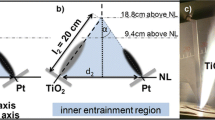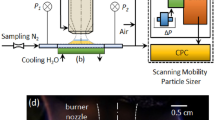Abstract
The extinguishing properties of aqueous suspensions with carbon nanoparticles (astralenes) used for extinguishment of liquid hydrocarbon flames were investigated. The extinguishment time (τ) was found to decrease by 75–80% with increasing of astralene concentrations (φ) from 0 vol.% to 0.5 vol.%. As the concentration is further increased above 1.0 vol.%, the value of τ also increases. Such changes are caused by the dependence of the latent heat of vaporization and heating rate of suspension to the boiling point on astralene concentration. The effects of nanoparticle concentration and size on nanofluid permittivity were determined. For nanofluids containing 1.0–1.5% astralenes, the permittivity was found to enhance with increasing the distances between nanoparticle agglomerates. Ultimately, these physical processes negatively affect the transport characteristics and extinguishing properties of the suspension.





source during extinguishment with: DW (a), suspensions at the content of 0.05 vol.% (b), 0.2 vol.% (c), 0.5 vol.% (d), 1.0 vol.% (e), 1.2 vol.% (f); 1.5 vol.% (g) astralenes






Similar content being viewed by others
References
Rasbash DJ, Rogowski ZW, Stark GWV (1960) Mechanisms of extinction of liquid fires with water sprays. Combust Flame 4:223–234. https://doi.org/10.1016/S0010-2180(60)80026-0
Jiang H, Zhang Q, Shi L (2015) Effective thermal conductivity of carbon nanotube-based nanofluid. J Taiwan Inst Chem Eng 55:76–81. https://doi.org/10.1016/j.jtice.2015.03.037
Terekhov VI, Kalinina SV, Lemanov VV (2010) The mechanism of heat transfer in nanofluids: state of the art (review). Part 2. Convective heat transfer. Thermophys Aeromechanics 17(2):157–171. https://doi.org/10.1134/S0869864310020010
Ding Y, Alias H, Wen D, Williams RA (2006) Heat transfer of aqueous suspensions of carbon nanotubes (CNT nanofluids). Int J Heat Mass Transf 49(1–2):240–250. https://doi.org/10.1016/j.ijheatmasstransfer.2005.07.009
Xie H, Lee H, Youn W, Choi M (2003) Nanofluids containing multiwalled carbon nanotubes and their enhanced thermal conductivities. J Appl Phys 94(8):4967–4971. https://doi.org/10.1063/1.1613374
Amiri A, Shanbedi M, Amiri H, Heris SZ, Kazi SN, Chew BT, Eshghi H (2014) Pool boiling heat transfer of CNT/water nanofluids. Appl Therm Eng 71(1):450–459. https://doi.org/10.1016/j.applthermaleng.2014.06.064
PonomarevA., Iudovich M (2015) Multi-layered carbon nanoparticles of the fulleroid type. US Patent No 9,090,752
Shames AI, Katz EA, Panich AM, Mogilyansky D, Mogilko E, Grinblat J, Belousov VP, Belousova IM, Ponomarev AN (2009) Structural and magnetic resonance study of astralen nanoparticles. Diam Relat Mater 18(2–3):505–510. https://doi.org/10.1016/j.diamond.2008.10.056
Ivanov AV, Toropov DP, Ivakhnyuk GK, Fedorov AV, Kuzmin AA (2017) Research of the extinguishing properties of water and hydrogel with carbon nanoparticles for liquidation burning of the petroleum products. Fire Explos Saf 26(8):31–44. https://doi.org/10.18322/PVB.2017.26.08.31-44
Ivanov AV, Toropov DP, Medvedeva LV, Kalinina ES (2019) Physical mechanism and method for fire liquid hydrocarbons by modified water suspensions of carbon nanostructures. Fire Explos Saf 28(1):22–34. https://doi.org/10.18322/PVB.2019.28.01.22-34
Suriyawong A, Wongwises S (2010) Nucleate pool boiling heat transfer characteristics of TiO2–water nanofluids at very low concentrations. Exp Thermal Fluid Sci 34(8):992–999. https://doi.org/10.1016/j.expthermflusci.2010.03.002
Hartnett JP, Irvine TF, Greene GA, Cho YI (1998) Advances in heat transfer, vol 31. Academic press, New York, p 484
Khaleduzzaman SS, Mahbubul IM, Shahrul IM, Saidur R (2013) Effect of particle concentration, temperature and surfactant on surface tension of nanofluids. Int Commun Heat Mass Transf 49:110–114. https://doi.org/10.1016/j.icheatmasstransfer.2013.10.010
Rugar D, Hansma P (1990) Atomic force microscopy. Phys Today 43(10):23–30. https://doi.org/10.1063/1.881238
von Hippel AR (1954) Dielectrics and waves. John Wiley and Sons, New York, p 439
Ivanov AV, Miftakhutdinova AA, Ivakhnyuk GK, Basharichev AV (2018) Physical and technological principles and methodology for the management of fire protection processes when treating liquid hydrocarbon in the conditions of stabilization of nanostructures. Fire Explos Saf 27(12):7–18. https://doi.org/10.18322/PVB.2018.27.12.7-18
Dumilin AI (2013) Suppression of the flame of combustible liquids by water spray cooling of their surface. Fire Explos Saf 22(8):81–84
Wang C, Xu H, Herreros JM, Lattimore T, Shuai S (2014) Fuel effect on particulate matter composition and soot oxidation in a direct-injection spark ignition (DISI) engine. Energy Fuels 28(3):2003–2012. https://doi.org/10.1021/ef402234z
Tanvir S, Qiao L (2012) Surface tension of nanofluid-type fuels containing suspended nanomaterials. Nanoscale Res Lett 7(1):1–10. https://doi.org/10.1186/1556-276X-7-226
Ponomarev AN, Yudovitch ME, Gruzdev MV, Yudovitch VM (2008) A nonmetallic nanoparticles in a superficial electromagnetic field Topological factor of mesostructures interference. Material 60(4):59–64
Dzyaloshinskii IE, Lifshitz EM, Pitaevskii LP (1961) The general theory of van der Waals forces. Adv Phys 10(38):165–209. https://doi.org/10.1080/00018736100101281
Yu W, Xie H (2012) A review on nanofluids: preparation, stability mechanisms, and applications. J Nanomater. https://doi.org/10.1155/2012/435873
Author information
Authors and Affiliations
Corresponding author
Additional information
Publisher's Note
Springer Nature remains neutral with regard to jurisdictional claims in published maps and institutional affiliations.
Rights and permissions
About this article
Cite this article
Ponomarev, A.N., Ivanov, A.V., Suyasova, M.V. et al. Investigation of Extinguishment process of Liquid Hydrocarbon Flames by Aqueous Suspensions of Astralenes. Fire Technol 57, 2061–2075 (2021). https://doi.org/10.1007/s10694-021-01094-1
Received:
Accepted:
Published:
Issue Date:
DOI: https://doi.org/10.1007/s10694-021-01094-1




